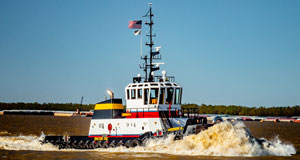In 1999, Bisso Towboat of Luling, La., introduced the first tractor tug on the Mississippi River with the delivery of Cecilia B. Slatten.
With the delivery of Andrew S. in November 2019, Bisso has introduced the first Tier 4 tractor tug on the mighty river. At 6,008 hp, it’s also the most powerful.
Main Iron Works in Houma, La., the towing company’s go-to-boatyard for nearly 30 years, built Andrew S. Bisso’s 13-boat fleet now includes eight z-drive tugs, boasting the largest tractor tug fleet on the inland waterways.
“The company is committed to z-drives,” Bisso Towboat President Scott Slatten said. “They have proven admirably suited to ship-assist work in tight spots and in the river’s difficult currents. They’re also not as vulnerable to river debris as once thought.”
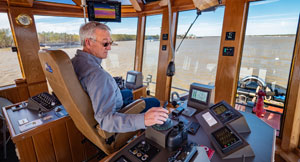 |
|
Capt. Michael Hilton steers Andrew S. on its way to a job on the Mississippi. |
According to Slatten, shipping companies and ship pilots are driving the demand for ASD tractor tugs. Bisso’s eight ASD tugs give the company something of a competitive advantage, especially with quality ship owners and operators.
Andrew S. is based on a proven 100-by-38-foot design developed by naval architect Greg Castleman. Bisso acquired the design after the construction of Cecilia B. Slatten more than two decades ago.
The hull form has proven itself with each successive tugboat. Bisso and Main Iron Works have modified the design tug by tug, arriving at what is essentially an enhanced version of Alma S., built in 2006.
Incremental improvements over the years include switching to Caterpillar engines, starting with Michael S. in 2010, and making connections for hoses, fuel, water and other fluids accessible outside the engine room. Keel-cooled air conditioning became standard in 2012 with delivery of William S.
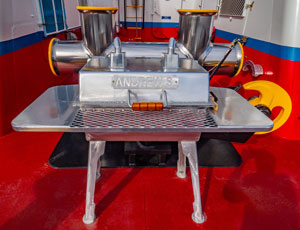 |
|
The custom-built grill installed on the aft deck is a Main Iron Works tradition. |
“It’s extremely efficient,” said Capt. Jon Davis, Bisso’s vice president of training. “The forced air is constantly being cooled by the river water.” The system also reduces maintenance costs.
Delivery of Becky S. in 2015 heralded an exciting upgrade from the crew’s point of view: A second head, located in a mudroom between the stacks. The change, now standard, allowed the engine room door to be moved from the galley to the mudroom, greatly reducing noise in crew quarters.
Andrew S., with twin 3,004-hp engines, has substantially more power than its most recent predecessor, the 4,480-hp Liz Healy built in late 2017. It also has 84 tons of bollard pull compared to Liz Healy’s 60 tons.
The new tug’s power train consists of two Caterpillar 3516E Tier 4 mains driving Kongsberg/Rolls-Royce z-drives. The ice-class drives have four-blade, 98.4-inch stainless-steel props in stainless-steel nozzles.
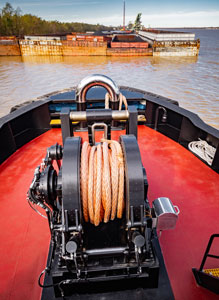 |
|
Bisso installed a JonRie Series 240 escort winch on the bow. |
“The boat has really good power,” said Kevin Beudreaux, the chief engineer.
The tug’s electrical service is provided by two 99-kW Marathon generators powered by John Deere 4045AFM85 engines. Soundproof insulation sharply reduces noise throughout the vessel, including its four bunkrooms.
Two 1,500-gallon, shipyard-built stainless-steel tanks feed diesel exhaust fluid (DEF) into the Caterpillar SCR system on Andrew S. The tanks are located inside the ballast tanks, keeping the product at a constant cool temperature to prevent degradation. Their location also saves space in the engine room.
The SCR system reduces NOx in engine exhaust emissions to meet EPA Tier 4 regulations. The dosing module mixes compressed air and DEF, sending it to the catalytic converter where it is injected into the exhaust stream. The water evaporates and the DEF is converted into ammonia.
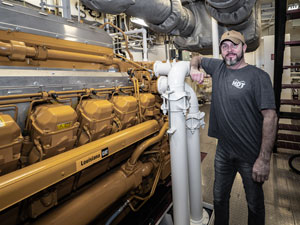 |
|
Chief engineer Kevin Beudreaux stands alongside one of two Caterpillar 3516E Tier 4 engines. |
“All of us are really impressed with how little smoke comes out of the stacks,” said Beudreaux. “It’s a super clean system.”
Bisso has fitted its tugs with JonRie bow winches since 2015. The JonRie Series 240 hydraulic auto-tensioning hawser winch on Andrew S. is wound with 500 feet of 3-inch Samson Saturn-12 line with 749,000 pounds of breaking strength. The winch is equipped with pedals at the helmsman’s feet, freeing the helmsman’s hands to concentrate on steering and propulsion controls. The line speed is up to 150 feet per minute.
A stainless-steel H-bitt and staple on the bow stem are standard on Bisso tugs, with a Washington Chain & Supply RSRH-100 quick-release pelican hook and a stainless-steel H-bitt on the stern. Main Iron Works also fabricated a stylish aluminum cooking grill for the crew.
The shoulder and quarter bitts are stainless steel and slanted inboard, as are the bulwarks, to tuck more easily under a ship’s counters.
Other changes to the vessel are less noticeable. Capt. Michael Hilton pointed to a few while idling Andrew S. at Poverty Point, waiting to meet the articulated tug-barge OSG Vision.
“We did away with the table bitt at the bow for taking the emergency towline, and fitted an emergency towline hook at the forward foot of the winch,” he said. In conjunction with the bow staple, the system allows for the employment of a full 80-ton bollard pull on an emergency tow.
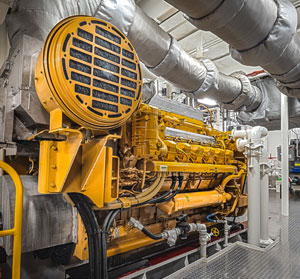 |
|
The twin Caterpillar mains aboard Andrew S. deliver 3,004 hp each, giving the tug substantially more power than its most recent predecessor, the 4,480-hp Liz Healy. |
Also at the bow, the bulwarks are canted inward 18 inches for one frame length to allow for more clearance under the sheer of a ship.
“The boat feels heavier than the other boats, and handles a little differently,” Hilton said. “I think it handles better on a ship because the stern, with the big wheels and larger drives, rides lower in the water and the bow higher.”
Where other vessels have one radar, Andrew S. has a compound radar system with two scanners and four radars. Two radar monitors bookend the chartplotter mounted to the ceiling above the helm console. Simrad supplied the electronics suite in the wheelhouse.
Hilton said the pace of acceleration from zero to 50 tons of pull is roughly the same as sister tugs, but there is slower acceleration from half-power to full-ahead. With slower acceleration at the top end, high bollard pull spikes are less likely.
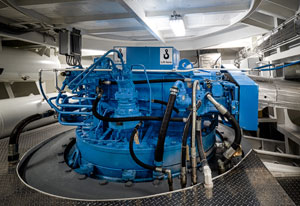 |
|
The Cat engines are paired with Kongsberg/ |
“So we get a smoother pull,” he said. “You don’t want spikes in tension when you’re over 50 tons. So, inadvertently, that’s an advantage.”
Building Andrew S. to Tier 4 standards, along with more powerful engines, a larger winch and ice-class drives, added about 35 percent to the total construction cost. But Slatten and his crews are pleased with the finished product.
“Provided business stays positive,” he said, “we hope to start building another tug, similar to the Andrew S., later this year.”

